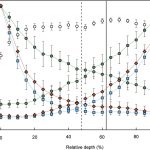Salicylic Acid Influences Root Meristem Patterning at Low Concentrations
High exogenous concentrations (>50 µM) of salicylic acid (SA) stimulate systemic acquired resistance (SAR), a vitally important adaptive immunity response that protects against a broad spectrum of pathogens. The transcription of PATHOGENESIS-RELATED GENE 1 (PR1) is rapidly induced in leaves upon both pathogen exposure and high exogenous concentrations of SA. At low concentrations (<50 µM), however, SA has specific effects on plant growth and development. The molecular nature of SA effects on root development is largely unknown, but it may be mediated by changes in  auxin signaling and auxin transport. To fill this gap in our knowledge, Pasternak et al. (10.1104/pp.19.00130) have analyzed the effect of SA on Arabidopsis (Arabidopsis thaliana) root development. They show that exogenous SA treatment at low (below 50 µM) and high (greater than 50 µM) concentrations affect root meristem development in two different PR1-independent ways. Low concentrations of SA promoted adventitious roots and altered architecture of the root apical meristem, whereas high-concentration SA inhibited all growth processes in the root. All of the concentrations of exogenous SA that were tested led to changes in auxin synthesis and transport. Auxin accumulation, induced by low concentrations of SA, caused the formation of more layers of columella initials, an additional cortical cell layer, and extra files of epidermis, cortex, and endodermis cells. This increase in the number of periclinal and tangential divisions in the root outer layers involved a CYCLIN D6;1-dependent mechanism. Thus, there appears to be two distinct bioactive concentration windows for SA: at low levels it acts as a developmental regulator and at high levels it acts as a stress hormone.
auxin signaling and auxin transport. To fill this gap in our knowledge, Pasternak et al. (10.1104/pp.19.00130) have analyzed the effect of SA on Arabidopsis (Arabidopsis thaliana) root development. They show that exogenous SA treatment at low (below 50 µM) and high (greater than 50 µM) concentrations affect root meristem development in two different PR1-independent ways. Low concentrations of SA promoted adventitious roots and altered architecture of the root apical meristem, whereas high-concentration SA inhibited all growth processes in the root. All of the concentrations of exogenous SA that were tested led to changes in auxin synthesis and transport. Auxin accumulation, induced by low concentrations of SA, caused the formation of more layers of columella initials, an additional cortical cell layer, and extra files of epidermis, cortex, and endodermis cells. This increase in the number of periclinal and tangential divisions in the root outer layers involved a CYCLIN D6;1-dependent mechanism. Thus, there appears to be two distinct bioactive concentration windows for SA: at low levels it acts as a developmental regulator and at high levels it acts as a stress hormone.



